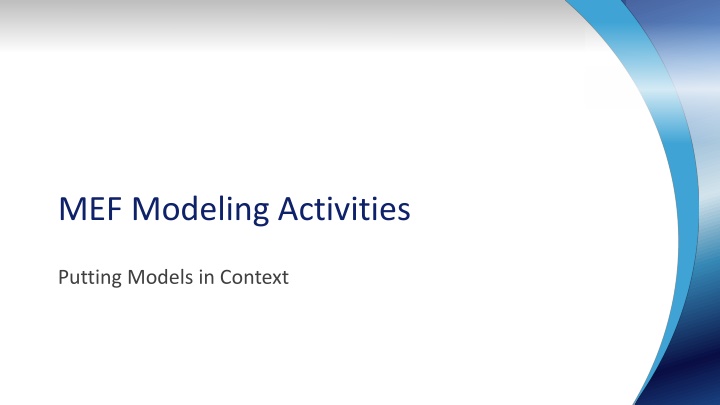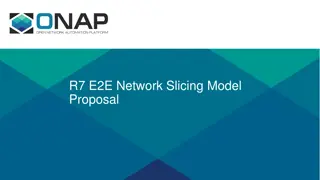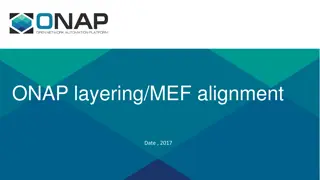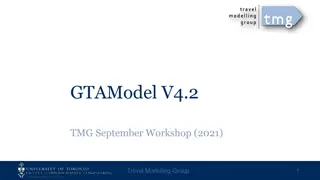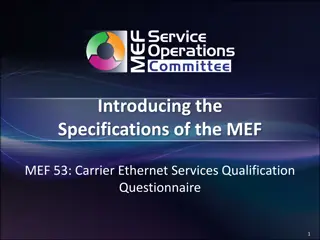Overview of MEF Modeling Activities in LSO and Network Evolution
This content outlines MEF's modeling activities in the context of Lifecycle Service Orchestration (LSO) and the evolving landscape of network services. It covers challenges, the vision for agile networks, lifecycle service orchestration capabilities, and the methodology for engineering LSO capabilities. Additionally, it touches upon product catalogs, ordering, performance reporting, and relevant reference architectures and frameworks in the industry.
Download Presentation

Please find below an Image/Link to download the presentation.
The content on the website is provided AS IS for your information and personal use only. It may not be sold, licensed, or shared on other websites without obtaining consent from the author.If you encounter any issues during the download, it is possible that the publisher has removed the file from their server.
You are allowed to download the files provided on this website for personal or commercial use, subject to the condition that they are used lawfully. All files are the property of their respective owners.
The content on the website is provided AS IS for your information and personal use only. It may not be sold, licensed, or shared on other websites without obtaining consent from the author.
E N D
Presentation Transcript
MEF Modeling Activities Putting Models in Context
Outline Challenges MEF s Third Network Vision Lifecycle Service Orchestration (LSO) Models in context LSO.net Conclusions 2
Challenges On-demand Services Quality Expectations Evolution of Networks and Services 3
MEFs Third Network Vision Enable agile networks Deliver assured connectivity services Orchestrated across network domains Between physical or virtual service endpoints 4
Lifecycle Service Orchestration Orchestration capabilities Backbone of the Lifecycle Services provided by The Third Network Provides orchestrated management and control of Connectivity Services 6
Lifecycle Service Orchestration (cont) Defines product, service, and resource abstractions Abstracts complexity from applications and users of Connectivity Services Infrastructure-agnostic (WAN technologies, NFV, SDN) 7
LSO Engineering Methodology Enables the transformation of LSO capabilities into interoperable, specific, consistent, and verifiable designs and implementations Generates re-usable engineering specifications and artifacts Captures LSO requirements, capabilities, functionality, behavior, processes, information, interfaces and APIs 9
LSO-Related & Modeling Activities Product Catalog, Ordering, Performance Reporting, Serviceability MEF LSO Reference Architecture and UNITE LSO Reference Architecture & Framework Static definitions of product / service / resource classes and their extensions i.e. MEF 7.3 Common Information Models API Implementations Certifications NRP API Test Suite MEF Service Definitions (including virtualization) MEF 6.2, 33, 51, 10.3, 26.2, etc. LSO Hackathon, ODL, OPNFV Reference Implementations Business Process Flows MEF 50 Specification of functional interfaces for LSO, i.e. Presto, Legato YANG/JSON Schema i.e. NRP API Specifications & Data Models Interface Profiles 10
UML to Data Schema Mappings Guidelines Guidelines UML to Yang UML to JSON UML Models Common Information Model Mapping Pruning/ Refactoring Mapping Process Mapping WG Specific Interface Profiles Interface Encodings Interface Data Schemas Core UML Modeling & Interface Development Process Document 11
LSO Reference Architecture and Framework Expresses the vision of the MEF LSO capabilities Characterizes management and control domains/entities that enable LSO capabilities Layered architecture 12
LSO Reference Architecture and Framework Management Interface Reference Points specify interactions between LSO components High level operational threads describe orchestrated Connectivity Service behavior and interactions among management entities 13
LSO-related Modeling Projects REFERENCE ARCHITECTURE Ordering Serviceability (WIP) CANTATA (CUS:BUS) Business Applications Business Applications SONATA (BUS:BUS) LEGATO (BUS:SOF) Customer Application Coordinator LEGATO (BUS:SOF) Yang Service Modules (Aligned with IETF) INTERLUDE (SOF:SOF) Service Orchestration Functionality Service Orchestration Functionality ALLEGRO (CUS:SOF) E PRESTO (SOF:ICM) PRESTO (SOF:ICM) Infrastructure Control and Management Infrastructure Control and Management Network Resource Provisioning (Based on ONF Core Model) ADAGIO (ICM:ECM) ADAGIO (ICM:ECM) Element Control and Management Element Control and Management Network Resource Model (Based on ONF Core Model) Network Infrastructure
LSO Management View Abstractions Information Class Examples per Management Abstraction View Management Abstractions LSO RA Context Product View Business Apps Service Orchestration (Provider domains & multi-domain) Service View Service Orchestration & Infrastructure Management (Subnetwork) Resource View Network & Topology Element & Equipment Element Control & Management
MEFs LSO.net LSO experimentation and incubation platform Support for LSO Hackathons OS/SDO collaboration environment Accelerates the development of data models and APIs 16
Conclusions Alignment and Velocity are fundamental Our focus is on entities on the service, service management and resource layers Models and abstractions must be understood in the right context 17
